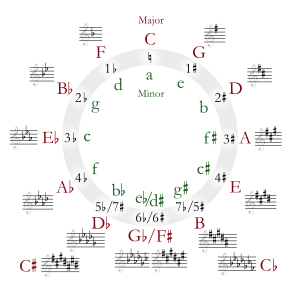C-flat major facts for kids
 |
||
| Relative key | A♭ minor | |
|---|---|---|
| Parallel key | C♭ minor enharmonic: B minor |
|
| Notes in this scale | ||
| C♭, D♭, E♭, F♭, G♭, A♭, B♭, C♭ | ||
C-flat major is a special type of major scale in music. A scale is a set of musical notes played in order. This scale starts on the note C-flat.
The key signature for C-flat major has seven flats. A flat sign (♭) lowers a note by a half step. So, every note in this scale is a flat note!
C-flat major has a relative minor called A-flat minor. It also has a parallel minor called C-flat minor. However, C-flat minor is rarely used. This is because it would need three double-flats in its key signature, which makes it very difficult to read and play.
Instead of C-flat major, musicians often use its enharmonic equivalent, which is B major. Enharmonic means two notes or keys sound the same but are written differently.
Most composers prefer to use B major because its key signature is much simpler. B major only has five sharps, which are easier to work with than seven flats.
Contents
Understanding C-flat Major
What is a Key Signature?
A key signature tells you which notes to play as sharps or flats in a piece of music. It is shown at the beginning of a musical staff. For C-flat major, the key signature has seven flats. This means every note (C, D, E, F, G, A, B) is played as a flat.
Relative and Parallel Keys Explained
Every major key has a relative minor key. They share the same key signature. For C-flat major, its relative minor is A-flat minor. They use the same seven flats.
A parallel key is a major key and a minor key that start on the same note. So, C-flat major and C-flat minor are parallel keys. But as we learned, C-flat minor is usually replaced by B minor because it's much simpler to read and play.
Why Do Composers Prefer B Major?
Composers often choose keys that are easier to read and play. C-flat major has seven flats, which can be tricky. Its enharmonic equivalent, B major, sounds exactly the same. However, B major only has five sharps in its key signature. This makes it a more practical choice for writing and performing music.
The Circle of Fifths
The Circle of fifths is a diagram that shows the relationships among the 12 musical keys. It helps musicians understand how keys are related and how many sharps or flats each key has. You can see C-flat major and its enharmonic twin, B major, on the circle.
| Diatonic Scales and Keys | |||||||||||||||||||||||||||||||||||||||||||||||||||||||
|---|---|---|---|---|---|---|---|---|---|---|---|---|---|---|---|---|---|---|---|---|---|---|---|---|---|---|---|---|---|---|---|---|---|---|---|---|---|---|---|---|---|---|---|---|---|---|---|---|---|---|---|---|---|---|---|
|
|||||||||||||||||||||||||||||||||||||||||||||||||||||||
| The table shows the number of sharps or flats in each scale. Minor scales are written in lower case. | |||||||||||||||||||||||||||||||||||||||||||||||||||||||
See Also
 In Spanish: Do bemol mayor para niños
In Spanish: Do bemol mayor para niños


